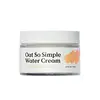What's inside
What's inside
 Benefits
Benefits

 Ingredients Side-by-side
Ingredients Side-by-side

Water
Skin ConditioningGlycerin
HumectantButylene Glycol
HumectantCaprylyl Methicone
Skin ConditioningTrehalose
Humectant1,2-Hexanediol
Skin ConditioningHydrogenated Polydecene
EmollientDiphenylsiloxy Phenyl Trimethicone
Skin ConditioningHydroxyethyl Urea
HumectantAcrylates/C10-30 Alkyl Acrylate Crosspolymer
Emulsion StabilisingHydrogenated Lecithin
EmulsifyingBeta-Glucan
Skin ConditioningAmmonium Acryloyldimethyltaurate/Vp Copolymer
Glycoproteins
Skin ConditioningDimethicone/Phenyl Vinyl Dimethicone Crosspolymer
Tromethamine
BufferingGlyceryl Acrylate/Acrylic Acid Copolymer
HumectantTrisodium EDTA
Water, Glycerin, Butylene Glycol, Caprylyl Methicone, Trehalose, 1,2-Hexanediol, Hydrogenated Polydecene, Diphenylsiloxy Phenyl Trimethicone, Hydroxyethyl Urea, Acrylates/C10-30 Alkyl Acrylate Crosspolymer, Hydrogenated Lecithin, Beta-Glucan, Ammonium Acryloyldimethyltaurate/Vp Copolymer, Glycoproteins, Dimethicone/Phenyl Vinyl Dimethicone Crosspolymer, Tromethamine, Glyceryl Acrylate/Acrylic Acid Copolymer, Trisodium EDTA
 Reviews
Reviews

Ingredients Explained
These ingredients are found in both products.
Ingredients higher up in an ingredient list are typically present in a larger amount.
1,2-Hexanediol is a synthetic liquid and another multi-functional powerhouse.
It is a:
- Humectant, drawing moisture into the skin
- Emollient, helping to soften skin
- Solvent, dispersing and stabilizing formulas
- Preservative booster, enhancing the antimicrobial activity of other preservatives
Ammonium Acryloyldimethyltaurate/Vp Copolymer (let's call it AAVC for short) is a synthetically created polymer. It's used as a film-forming agent and used to thicken the consistency of products.
AAVC is able to increase the consistency and viscosity of products due to its large molecule size. It also prevents ingredients from separating.
Butylene Glycol (or BG) is used within cosmetic products for a few different reasons:
Overall, Butylene Glycol is a safe and well-rounded ingredient that works well with other ingredients.
Though this ingredient works well with most skin types, some people with sensitive skin may experience a reaction such as allergic rashes, closed comedones, or itchiness.
Learn more about Butylene GlycolTrehalose is a disaccharide made of two glucose molecules (glucose is sugar!). Trehalose is used to help moisturize skin. It also has antioxidant properties.
As a humectant, trehalose helps draw moisture from the air to your skin. This helps keep your skin hydrated.
Due to its antioxidant properties, trehalose may help with signs of aging. Antioxidants help fight free-radical molecules, unstable molecules that may damage your skin.
In medicine, trehalose and hyaluronic acid are used to help treat dry eyes.
Some animals, plants, and bacteria create trehalose as a source of energy to survive freeze or lack of water.
Learn more about TrehaloseWater. It's the most common cosmetic ingredient of all. You'll usually see it at the top of ingredient lists, meaning that it makes up the largest part of the product.
So why is it so popular? Water most often acts as a solvent - this means that it helps dissolve other ingredients into the formulation.
You'll also recognize water as that liquid we all need to stay alive. If you see this, drink a glass of water. Stay hydrated!
Learn more about Water